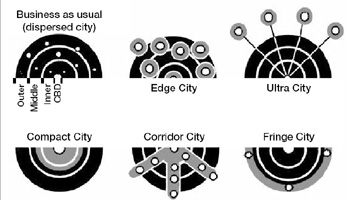 |
 |
 |
 |
 |
 |
 |
 |
 |
 |
 |
Cross sector links
The transport sector is closely connected to urban land use patterns, to the urban form. Today the tendency in many cities is urban dispersion: the cities grow larger by area, and more travel is needed. Population density and city form are the basic factors behind travel need - that is why the land use and transport should be planned hand in hand.

Structural options for urban growth (Newton, 1999, (4)).
Although the meaning of the sustainability concept is often involved in controversy, when it comes to the transport sector there is a wide consensus that it will surely mean reducing travel needs. This will favour modal split policies in place of public transport, a greater emphasis on cycling and walking, decreased pollution emissions and increased overall safety standards.
However, prevailing trends seem to point into an opposite direction. Our cities are loosing their traditional form and structure and are becoming more dispersed and divided. Traffic levels are continuously growing and the modal split is more and more unbalanced in favour of the private car and the lorry transport. Post modern values of individual freedom and life style fashions are surely associated with these trends, which might also explain why planners and politicians find themselves with little room for manoeuvre when trying to implement sustainable transport policies.
In this context the way forward is bound to favour an increased attention to the awareness of the environmental and social impacts of transport systems, through more information and an open and participated debate. The result should aim to produce a desired change of attitudes towards a more sustainable transport sector.